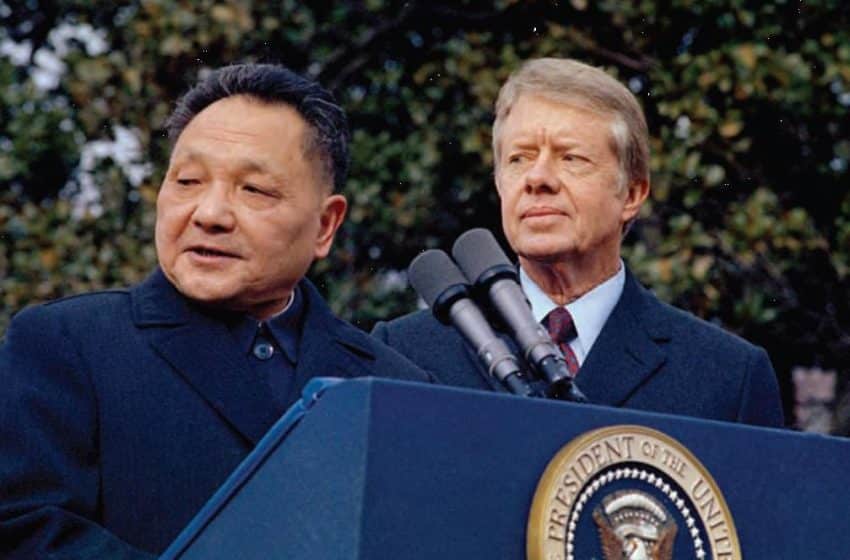What Can China Learn from Love Canal?
CCTV aired an investigative report on April 17 linking illnesses among students at a top secondary school in China’s Jiangsu province to the school’s location next to a trio of shuttered chemical plants. The story struck a chord with the Chinese public, inciting passionate reactions on social media and a flurry of follow-up reports. Chinese and foreign media swiftly pointed out parallels between this case and the events that transpired at the Love Canal neighborhood in the United States half a century earlier. Likewise, this incident could serve as a rallying point to patch remaining gaps in China’s rapidly developing system of environmental laws.
The new campus of Changzhou Foreign Languages School opened last September after the results of an environmental assessment deemed the school’s location to be compliant with national standards. However, by December, many students had fallen ill, causing parents to petition the school and commission their own series of testing reports. According to the CCTV investigation, 493 out of 641 students examined by doctors were diagnosed with ailments ranging from skin conditions to abnormal white blood cell counts and even leukemia, although school officials dispute that any cases of leukemia were found.
Tests indicate the school’s site to be contaminated with a variety of toxic substances associated with the production of pesticides and other chemicals. Based on samples from 2012, groundwater levels of chlorobenzene, a chemical linked to kidney, liver and nervous system damage, measured over 94,000 times the legal standard. Former workers from one of the nearby factories, pesticide manufacturer Changlong Chemical, have reported that the factory flouted environmental laws and buried unknown amounts of untreated chemical waste just beneath the earth’s surface before the facility was relocated in 2010.
Love Canal as a driver for change
To those aware of Love Canal, the Changzhou case feels eerily familiar, symbolizing the dangers of industrial pollution. In 1953, a former canal-turned-dumpsite containing over 22,000 sealed barrels of toxic waste was sold for $1 to the Niagara Falls City School District in New York. An elementary school and the nearby Love Canal neighborhood were subsequently erected at the site. Then, in the wake of abnormally heavy rains in 1978, the storage barrels began corroding and leaching toxic substances into soil and groundwater. Trees died, residents exhibited skin rashes and low white blood cell counts, and abnormally high rates of miscarriages and birth defects were recorded.
For the United States, the 1960’s and 1970’s saw the passing of a slew of laws crucial to environmental regulation, including the National Environmental Planning Act (NEPA) for environmental assessments and the Clean Air Act and Clean Water Act. In fact, the United States had passed its first law to regulate hazardous waste disposal, the Resource Conservation and Recovery Act (RCRA), only two years before reports of illnesses at Love Canal bubbled to the surface of national attention in 1978. But when Love Canal came to light, the prevailing attitude was still “out of sight, out of mind.” Laws lacked provisions to manage the cleanup of toxic dumps or guarantee means for the public to know the location of hazardous chemicals that might pose a risk to public health.
The Love Canal episode exposed critical shortcomings in the United States’ nascent set of environmental laws and provoked swift action from the national government. By 1979, U.S. President Jimmy Carter issued a disaster declaration that led over 900 affected families to be evacuated and compensated for their losses. The next year, the government enacted the Comprehensive Environmental Response, Compensation and Liability Act (CERCLA, or Superfund), its first law to regulate the cleanup of toxic sites requiring both immediate and long-term action. The EPA reported that 375 sites had been fully cleaned up as of 2014. CERCLA also established a liability mechanism to defray remediation costs. Within five years of the law’s passing, over $1.6 billion had also been collected and pooled into a literal “superfund” to provide resources for remediating hazardous sites when authorities are unable to identify a responsible party.
Under CERCLA, any party that disposes of waste at a particular site, legally or otherwise, may be sued by the government to be held liable for cleanup costs. This system, known as strict, joint and several liability, places the burden of cleanup costs on waste generators rather than disposal facility operators, forcing production facilities to be held accountable for their waste management. The potential costs of being forced to pay exorbitant cleanup fees often impose a hefty load on a company’s profitability. For instance, based on CERCLA’s provisions, the company responsible for dumping the waste at Love Canal eventually paid $129 million in restitution.
CERCLA’s focus on fear of future liability aims to incentivize responsible disposal of hazardous waste, and to curb irresponsible behavior stemming from the low cost of violations. This deterrent effect is at the core of the law’s reasons for passage. Philip Cummings, the chief counsel of the Senate Environment Committee when CERCLA was drafted, wrote, “The main purpose of CERCLA is to make spills or dumping of hazardous substances less likely through liability, enlisting business and commercial instinct for the bottom line in place of traditional regulation.” Although this aspect of the law is one of the most difficult to measure, it will likely become more important as sites are cleaned up.
Love Canal also contributed to the push for public reporting of hazardous discharges. Following the 1984 Bhopal chemical disaster in India and a similar accident at a Union Carbide plant in West Virginia, in 1986, American lawmakers passed the Emergency Community Planning and Right-to-Know Act (ECPRA). The law requires industrial facilities to report annual releases and transfers of certain toxic chemicals to the Toxic Release Inventory (TRI) so that the public may access this data. It had an immediate effect by incentivizing big corporations, such as Monsanto and AT&T, to publicly commit to emissions reductions. Indeed, between 1988 and 1994, releases of the 17 most toxic chemicals fells by 51 percent.
Changzhou highlights remaining gaps in China’s environmental laws
Over the past decade, China has developed and reinforced its own environmental regulations, passing key legislation such as the 2014 amendments to its 1989 Environmental Protection Law, which strengthen penalties for polluters, enshrine the public’s environmental right-to-know, and establish a framework for environmental public interest ligation. Nevertheless, much like Love Canal did for the United States in the 1970s, the Changzhou case highlights critical gaps that remain in China’s network of environmental laws: lack of legislation regulating the clean-up of toxic waste dumps and other polluted sites, and lack of a unified system to satisfy the public’s right-to-know about transfer and release of hazardous chemicals.
Recent government actions indicate that China is finally shifting its attention from air and water pollution to the more complicated issues posed by soil pollution. A Ministry of Environmental Protection (MEP) circularfrom 2012 establishes guidelines for cleaning up brownfields for redevelopment. More importantly, a draft national Soil Pollution Prevention and Control Law has already passed through ten drafts and will reportedly enter into the legislative agenda in 2017. Drafts of the Soil Law reportedly allow the government to determine who pays for cleanup costs, and also create new mechanisms to finance remediation efforts. A ten-point soil action plan is also being drawn up. And in July 2015, Beijing pledged approximately $450 million over the next three years to help 30 Chinese cities tackle heavy metal pollution.
China’s efforts, which mirror the development of Superfund, should also consider how to address the law’s shortcomings. Critics of Superfund point to the fact that in many cases it is unclear what qualifies as effective cleanup, and there is a lack of accountability toward where hazardous waste ends up after a site is remediated. Moreover, there is also the issue of where to source the funds for cleanup, especially as U.S. taxes on chemical producers have expired. Some Chinese experts such as Gao Shengda, secretary of the China Environmental Remediation Association, have outwardly called for liability-focused legislation to address China’s pollution problems. Other Chinese experts have suggested looking into new models, such as those based on public-private partnerships, although these models may weaken the effect of future liability toward deterring pollution.
The Changzhou incident has also refocused China’s attention on a type of soil pollution that has largely escaped official attention – urban soil pollution at former industrial sites, such as those for heavy metal and petrochemical production, that have since been converted into sites for residential or commercial use. In a 2014 interview, Gao noted that there had yet to be any confirmed cases in China of soil pollution causing public health issues in urban areas, as opposed to soil pollution of rural farmland. In this regard, if the U.S. experience is any indication, Changzhou may serve as the whistleblower to address a widespread problem. For example, in the year after Love Canal first caught the public’s attention, more than 300 incidents of groundwater contamination were discovered in the United States, and the U.S. EPA determined that 2,600 unlined impoundments of liquid wastes were situated within one mile of a groundwater supply well.
Meanwhile, China’s system for environmental information disclosure has advanced tremendously since the Measures on Environmental Information Disclosure went into effect in 2008. A supplementary regulation from 2014 requires key polluters to disclose real-time automatic monitoring data for air and wastewater discharges via online platforms established by local environmental protection bureaus (EPBs). China is now an epicenter for the chemical industry, standing as the world’s top manufacturer and consumer of over 20 chemicals. Creating a unified system for publicly reporting the release and transfer of hazardous chemicals along the lines of the United States’ TRI or Europe’s pollution release and transfer register (PRTR) system would both incentivize responsible discharge and provide an important means of protecting public health.
Compared to the United States, China has the advantage of developing its environmental policies in the information age. New technologies, such as mobile phones and social media, facilitate public supervision of polluters and simplify public access to environmental information. Information technology also heightens the public supervision risks for polluters: after the Changzhou case came to light on a national level, the social media hashtag #pollutedschool attracted over 30 million views within a day after the CCTV report.
For China, the biggest lesson from Love Canal is that legislation must be powerful enough that polluters take no chances. In a speech on April 20, Chinese Environmental Minister Chen Jining responded to the Changzhou incident, remarking, “We need to strengthen preventative measures. Let us not just tackle this one problem; the price is too big. Figuring out how to solve problems before they occur will be a very important tool for management.” With stronger policies in place, change must come from the ground level, by stopping pollution at the source.
Kate Logan is Green Choice Project Manager at the Institute of Public & Environmental Affairs (IPE), a non-profit environmental organization registered in Beijing that promotes information disclosure and public participation as means of improving environmental governance mechanisms, emissions reductions and environmental quality. Prior to joining IPE, she served as a research fellow on the China Environmental Law & Governance Project at the Natural Resources Defense Council (NRDC) in Beijing.
By KATE LOGAN Apr. 26, 2016 on The Diplomat
Read more here








